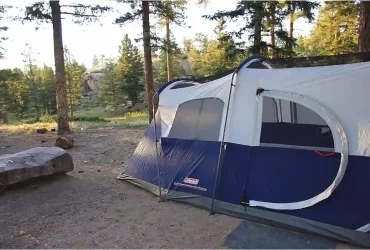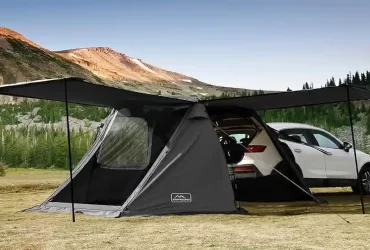Camping may seem unrelated to the Medieval era, but how tents have been built over time can teach you something. The reason for your question may be that you are wondering why.
During the medieval era, most tents were constructed of wool or linen which resembled blankets. Although imitation tents are still available in modern times made of linen and cotton canvas, these materials are better treated to resist moisture. A cone-shaped tent being held up by ropes and wooden poles was typical during medieval times.
What Were Medieval Tents Made Of?
Tents were made from the same materials that were used to make sheets and covers during the medieval period. Cotton used to be a common material in those days, according to common belief. There is no truth to this.
It was common to use canvas materials, but cotton was less common. Canvas made from wool and linen were the most commonly used materials. In addition to being useful, linen was also more expensive. It was lighter and easier to handle because there was less weight.
During this time, wool was common at home and most tents were made of it. In addition to its ability to tolerate cold weather, wool’s weight made it also effective at handling wind. While this had some benefits, there were also some downsides. It was nearly impossible to transport wet wool and it was extremely hot.
They carried smaller throw tents and lighter tent materials when they travel. Tents used in medieval times were heavier and larger, transported by wagon or pack animal, and then erected once the group had settled at their destination.
Tents made from cotton canvas are common in modern medieval times. Camping tents are typically made of polyester, but they may also be made of synthetic polycotton. Wool is relatively uncommon these days in medieval-style tents. Renaissance Fairs around the world usually feature these tents.
Today’s tents designed after this historical style are more resistant to damage caused by water and UV rays due to their water and sun-proofing treatments. The modern materials are also better at handling hot temperatures in addition to being breathable. Additionally, medieval tents were susceptible to mold, which caused serious problems.
Also like this:
What Were Medieval Tents Used For?

During the Middle Ages, tents were used mainly as temporary accommodations or rooms for traveling groups. Military groups and high-level citizens, along with their entourages, tended to use these cameras most often. Simple tents and shelters were constructed by soldiers using linen or wool drop sheets and poles during combat.
The tents of nobles and merchants were often more elaborate, often called pavilions. Inside these pavilions, there was a great deal of space. It usually has a cone-shaped shape, and the sides can be dropped or lifted based on the weather.
Listed below are the reasons why these tents were used:
- Eating spaces
- Storage
- Selling products
- Nobility or rich people sleeping
- And more!
Larger tents were available for housing entire groups while single occupancy tents were available for sleeping.
Where Can I Buy A Medieval Tent?
There are several places where you can find medieval tents if you are interested in them. It’s not impossible to find some, but you’ll have to work for them. Here are some suggestions you can follow instead.
Medieval Market
Medieval-themed products can be found on the website. It offers a wide range of tents with different sizes and styles. The company does not only color and style them according to your specifications, but they also charge extra for that service. During the production of Medieval Market’s products, high-quality processes are used to ensure durability and longevity. These medieval tents look fantastic and will surely impress anyone interested in medieval tents
Online Retailers
Some effort is required to shop for medieval-looking tents on Amazon and other shopping platforms. Check out this Danchel Bell Tent (click to check Amazon price) or this Wenzel Tipi tent, which is cone-shaped. Compared to medieval cone tents, bell tents are modern versions.
Panther Primitives
Panther Primitives manufactures various types of tents, including medieval tents. Although this company makes quality tents, they are not as devoted to historical styles as other companies.
Renaissance Fairs
Renaissance fairs are a good place to purchase medieval tents. There will be an easy access point and packages that are easily packaged. It is usually fine both in terms of appearance and functionality. Despite being less controllable than other tents, they can sometimes be more affordable.
Tent Smiths
At Tent Smiths, you can find historical period tents related to the medieval era. Their tents and pavilions are manufactured and treated to match the period as closely as possible. The biggest disadvantage is the higher price. There is a lot of expertise and hard work that went into creating this perfection, so you will not be disappointed.
Also like this:
Final Thoughts
Thank you for spending time learning about medieval tent materials. Wool and linen were the most common materials used to construct these cone-shaped shelters. Find out how to get your very own and make your campsite a favorite among your campmates by clicking on the links above.





Leave a Reply
View Comments